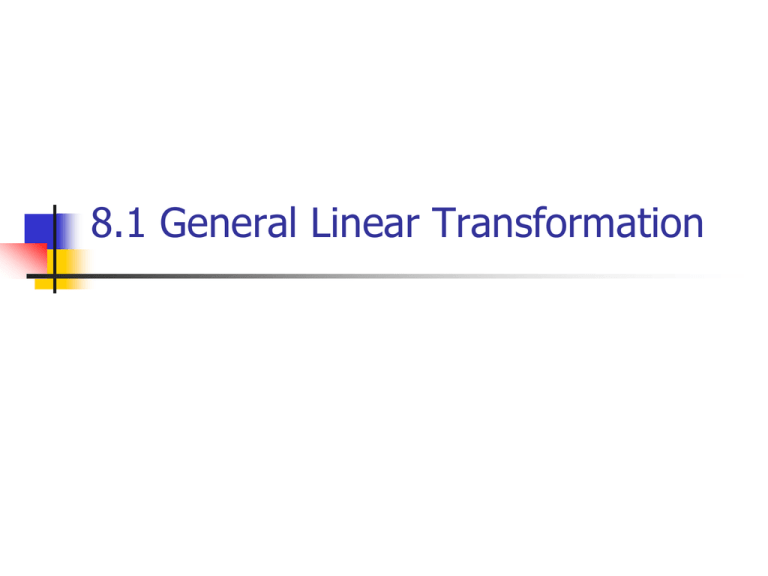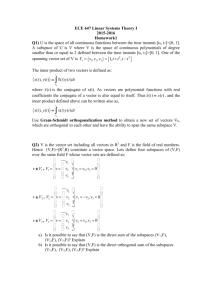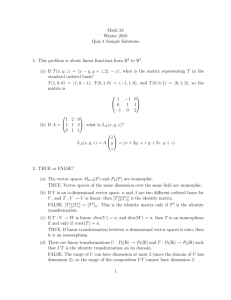Document
advertisement

8.1 General Linear Transformation
Definition
If T: V→W is a function from a vector space V into a vector
space W, then T is called a linear transformation from
V to W if for all vectors u and v in V and all scalors c
T (u+v) = T (u) + T (v)
T (cu) = cT (u)
In the special case where V=W, the linear transformation
T:V→V is called a linear operator on V.
Example 2
Zero Transformation
The mapping T:V→W such that T (v)=0 for every v in V is
a linear transformation called the zero transformation.
To see that T is linear, observe that
T (u+v) = 0. T (u) = 0, T (v) = 0. And T (k u) = 0
Therefore,
T (u+v) =T (u) +T (v) and T (k u) = kT (u)
Example3
Identify Operator
The mapping I: V→V defined by I (v) =
v is called the identify operator on V.
Example 4
Dilation and Contraction operators
Let V be any vector space and k any fixed scalar. The
function T:V→V defined by
T (v) = k v
is linear operator on V.
Dilation: k > 1 تمدد
Contraction: 0 < k < 1 انكماش
Dilation and Contraction operators
Example 7
A Linear Transformation from a space V to Rn
Let S = {w1 , w2 , …, wn } be a basis for an ndimensional vector space V, and let
(v)s = (k1, k2, …, kn )
Be the coordinate vector relative to S of a vector v in V;
thus
v = k1 w1 + k2 w2 + …+ kn wn
Define T: V→Rn to be the function that maps v into its
coordinate vector relative to S; that is,
T (v) = (v)s = (k1, k2, …, kn )
The function T is linear transformation. To see that this is so,
suppose that u and v are vectors in V and that
u = c1 w1+ c2 w2+ …+ cn wn
and
v = d1 w1+ d2 w2+ …+ dn wn
Thus,
(u)s = (c1, c2, …, cn ) and (v)s = (d1, d2, …, dn )
But
u+v = (c1+d1) w1+ (c2+d2) w2+…+ (cn+dn) wn
k u = (kc1) w1 +(kc2) w2 +…+ (kcn) wn
So that
(u+v)s = (c1+d1, c2+d2 …, cn+dn )
(k u)s = (kc1, kc2, …, kcn )
Therefore,
(u+v)s = (u)s + (v)s and (k u)s = k (u)s
Expressing these equations of T, we obtain
T (u+v) = T (u) + T (v) and T (k u) = kT (u)
Which shows that T is a linear transformation.
REMARK.
The computations in preceding example could
just as well have been performed using coordinate
matrices rather than coordinate vectors; that is ,
[u+v] = [u]s +[v]s and [k u]s = k [u]s
Example 8
A Linear Transformation from pn to pn+1
Let p = p(x) = C0 X + C1X2 + …+ CnX n+1 be a polynomial in Pn ,
and define the function T: Pn → Pn+1 by
T (p) = T (p(x)) = xp(x)= C0 X + C1X2 + …+ CnX n+1
The function T is a linear transformation, since for any scalar k
and any polynomials p1 and p2 in Pn we have
T (p1+p2) = T (p1(x) + p2 (x)) = x (p1(x)+p2 (x))
= x p1 (x) + x p2 (x) = T (p1) +T (p2)
and
T (k p) = T (k p(x)) = x (k p(x))= k (x p(x))= k T(p)
Example 9
A linear Operator on Pn
Let p = p(x) = c0 X + c1X2 + …+ cnX n+1 be a
polynomial in Pn , and let a and b be any scalars. We
leave it as an exercise to show that the function T
defined by
T (p) = T(p(x)) = p (ax+b) = c0 + c1 (ax+b) + …+
cn(ax+b) n
is a linear operator. For example, if ax+b = 3x – 5, then
T: P2 → P2 would be the linear operator given by the
formula
T (c0 + c1x+ c2 x2 ) = c0 + c1 (3x-5) + c2 (3x-5) 2
Example 11
A Linear Transformation from C1(-∞,∞) to F (-∞,∞)
Let V = C1(-∞,∞) be the vector space of functions with
continuous first derivatives on (-∞,∞) and let W = F
(-∞,∞) be the vector space of all real-valued
functions defined on (-∞,∞).
Let D:V→W be the transformation that maps a function
f = f (x) into its derivative; that is,
D (f) = f’(x)
From the properties of differentiation, we have
D (f+g) = D (f)+D (g) and D (k f) = kD (f)
Thus, D is a linear transformation.
Example 12
A Linear Transformation from C (-∞,∞) to C1(-∞,∞)
Let V = C (-∞,∞) be the vector space of
continuous functions on (-∞,∞) and let W =
C1(-∞,∞) be the vector space of functions
with continuous first derivatives on (-∞,∞).
Let J:V→W be the transformation
that maps a
x
f = f (x) into the integral 0 f (t )dt . For
example, if f=x2 , then
x
J (f) = t2dt =
0
From the properties of integration, we have
x
J (f+g) = 0 ( f (t ) g (t ))dt = 0 f (t )dt + 0 g (t )dt
= J (f) + J (g)
x
x
x
J (c f) = 0 cf (t )dt = c f (t )dt = cJ (f)
x
0
So J is a linear transformation.
Example 13
A Transformation That Is Not Linear
Let T:Mnn →R be the transformation that maps an n × n
matrix into its determinant; that is,
T (A) = det (A)
If n>1, then this transformation does not satisfy either
of the properties required of a linear transformation.
For example, we saw Example 1 of Section 2.3 that
det (A1+A2) ≠ det (A1) + det (A2)
in general. Moreover, det (cA) =C n det (A), so
det (cA) ≠ c det (A)
in general. Thus, T is not linear transformation.
Properties of Linear Transformation
If T:V→W is a linear transformation, then for any vectors v1 and
v2 in V and any scalars c1 and c2 , we have
T (c1 v1 + c2 v2) = T (c1 v1 ) + T (c2 v2) = c1T (v1 ) + c2T (v2)
and more generally, if v1 , v2 , …, vn are vectors in V and c1 , c2 , …,
cn are scalars, then
T (c1 v1 + c2 v2 +…+ cn vn ) =
c1T (v1 ) + c2T ( v2 ) +…+ cnT ( vn )
(1)
Formula (1) is sometimes described by saying that linear
transformations preserve linear combinations.
Theorem 8.1.1
If T:V→W is a linear transformation, then:
(a) T (0) = 0
(b) T (-v ) = -T (v ) for all v in V
(c)
T (v-w ) = T (v ) - T (w) for all v and w in
V
Proof.
(a) Let v be any vector in V. Since 0v=0, we have
T (0)=T (0v)=0T (v)=0
(b) T (-v) = T ((-1)v) = (-1)T (v)=-T (v)
(c) v-w=v+(-1)w; thus,
T (v-w)= T (v + (-1)w) = T (v) + (-1)T (w)
= T (v) -T (w)
Finding Linear Transformations from
Images of Basis
If T:V→W is a linear transformation, and if {v1 , v2 , …,
vn } is any basis for V, then the image T (v) of any
vector v in V can be calculated from images
T (v1), T (v2), …, T (vn)
of the basis vectors. This can be done by first
expressing v as a linear combination of the basis
vectors, say
v = c1 v1+ c2 v2+ …+ cn vn
and then using Formula(1) to write
T (v) = c1 T (v1) + c2 T (v2) + … + cn T (vn)
In words, a linear transformation is completely
determined by its images of any basis vectors.
Example 14
Computing with Images of Basis Vectors
Consider the basis S = {v1 , v2 , v3 } for R3 ,
where v1 = (1,1,1), v2 =(1,1,0), and v3 =
(1,0,0). Let T: R3 →R2 be the linear
transformation such that
T (v1)=(1,0), T (v2)=(2,-1), T (v3)=(4,3)
Find a formula for T (x1 , x2 , x3 ); then use this
formula to compute T (2,-3,5).
Solution.
We first express x = (x1 , x2 , x3 ) as a linear combination of
v1 =(1,1,1), v2 =(1,1,0), and v3 = (1,0,0). If we write
(x1 , x2 , x3 ) = c1 (1,1,1) + c2 (1,1,0) + c3 (1,0,0)
then on equating corresponding components we obtain
c1 + c2 + c3 = x1
c1 + c2
= x2
c1
= x3
which yields c1 = x3 , c2 = x2 - x3 , c3 = x1 - x2 , so that
(x1 , x2 , x3 ) = x3 (1,1,1) + (x2 - x3 ) (1,1,0) + (x1 - x2 ) (1,0,0)
= x3 v1 + (x2 - x3 ) v2 + (x1 - x2 ) v3
Thus,
T (x1 , x2 , x3 ) = x3 T (v1) + (x2 - x3 ) T (v2) + (x1 - x2 ) T (v3)
= x3 (1,0) + (x2 - x3 ) (2,-1) + (x1 - x2 ) (4,3)
= (4x1 -2x2 -x3 , 3x1 - 4x2 +x3)
From this formula we obtain
T (2 , -3 , 5 ) =(9,23)
Composition of T2 with T1
If T1 :U→V and T2 :V→W are linear
transformations, the composition of T2 with
T1 , denoted by T2 。T1 (read “T2 circle T1 ”),
is the function defined by the formula
(T2 。T1 )(u) = T2 (T1 (u))
where u is a vector in U
(2)
Theorem 8.1.2
If T1 :U→V and T2 :V→W are linear
transformations, then (T2 。T1 ):U→W is also
a linear transformation.
Proof.
If u and v are vectors in U and c is a scalar, then it
follows from (2) and the linearity of T1 andT2 that
(T2 。T1 )(u+v) = T2 (T1(u+v)) = T2 (T1(u)+T1 (v))
= T2 (T1(u)) + T2 (T1(v))
= (T2 。T1 )(u) + (T2 。T1 )(v)
and
(T2 。T1 )(c u) = T2 (T1 (c u)) = T2 (cT1(u))
= cT2 (T1 (u)) = c (T2 。T1 )(u)
Thus, T2 。T1 satisfies the two requirements of a linear
transformation.
Example 15
Composition of Linear Transformations
Let T1 : P1 → P1 and T2 : P2 → P2 be the linear transformations
given by the formulas
T1(p(x)) = xp(x) and T2 (p(x)) = p (2x+4)
Then the composition is (T2 。T1 ): P1 → P2 is given by the formula
(T2 。T1 )(p(x)) = (T2)(T1(p(x))) = T2 (xp(x)) = (2x+4)p (2x+4)
In particular, if p(x) = c0 + c1 x, then
(T2 。T1 )(p(x)) = (T2 。T1 )(c0 + c1 x)
= (2x+4) (c0 + c1 (2x+4))
= c0 (2x+4) + c1 (2x+4)2
Example 16
Composition with the Identify Operator
If T:V→V is any linear operator, and if I:V→V is the
identity operator, then for all vectors v in V we have
(T。I )(v) = T (I (v)) = T (v)
(I。T )(v) = I (T (v)) = T (v)
It follows that T。I and I。T are the same as T ; that is,
T。I=T and I。T = T
(3)
We conclude this section by noting that compositions
can be defined for more than two linear
transformations. For example, if
T1 : U → V and T2 : V→ W ,and T3 : W→ Y
are linear transformations, then the composition T3。T2。
T1 is defined by
(T3。T2。T1 )(u) = T3 (T2 (T1 (u)))
(4)






